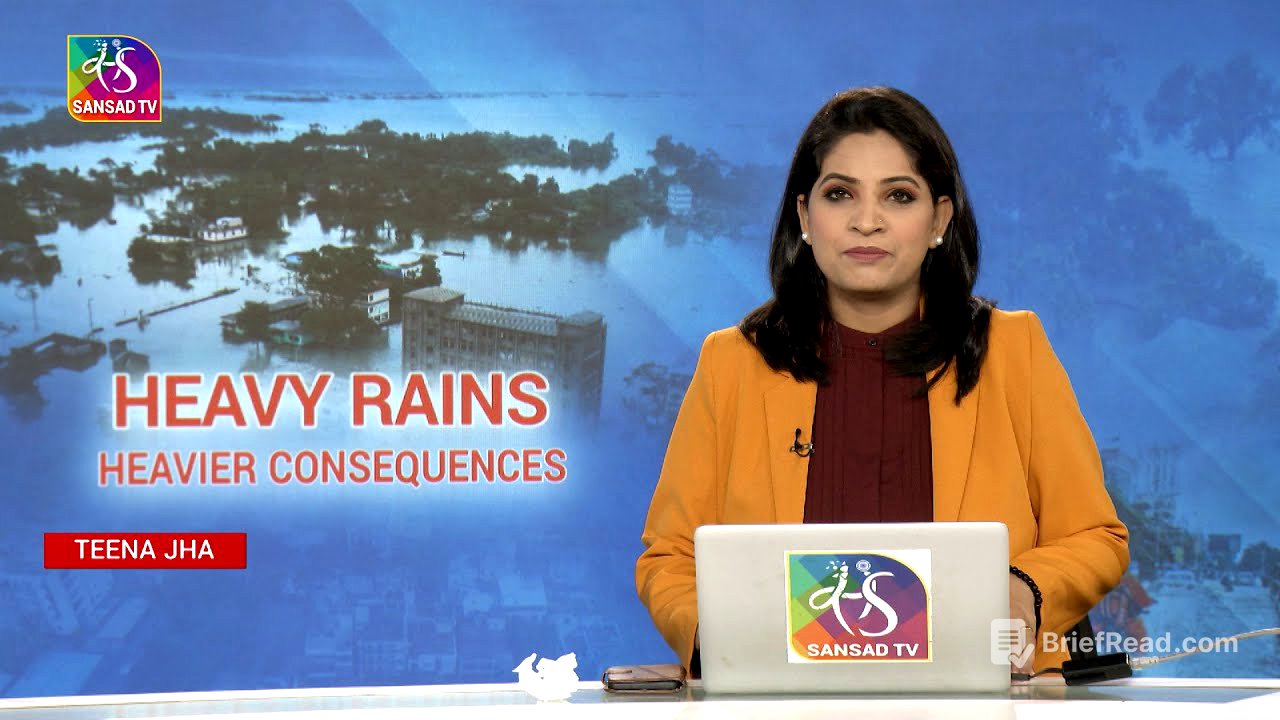TLDR;
This episode of "Perspective" on Sansad TV discusses the increasing frequency and intensity of floods and extreme weather events across the globe, from Himachal Pradesh to Texas. The discussion explores whether these events are solely attributable to climate change or if other factors, such as unplanned development and inadequate infrastructure, play a significant role. The guests also discuss strategies for building climate resilience and the importance of integrating climate risk considerations into development programs.
- Climate change is altering weather patterns, leading to more frequent and intense extreme weather events.
- Unplanned development, concretization, and deforestation exacerbate the impact of rainfall, turning moderate events into major disasters.
- There is a need to shift from a reactive approach to a proactive one, focusing on better planning, implementation of state action plans, and integration of climate risk resilience into development programs.
Introduction: The Global Impact of Extreme Weather [0:14]
The program begins by highlighting recent devastating floods in Himachal Pradesh, Nagpur, and Texas, illustrating the widespread impact of extreme weather events. These incidents raise questions about whether they represent a new normal influenced by climate change and whether sufficient measures are being taken to build climate resilience. The host introduces the guests, Suruchi Badwal and Dr. Vinot Tar, who will discuss these issues.
The Changing Nature of Extreme Weather Events [2:34]
Suruchi Badwal explains that the observed weather pattern changes are linked to a larger climate change pattern. The "new normal" involves continuous shifts in the extreme nature of events, with the world becoming hotter and wetter. This leads to increased heavy precipitation, flash floods, and water logging in many regions, including India and the United States. The return periods for these events are shortening, with events that used to occur every 15-20 years now happening every 5-7 years, increasing both frequency and intensity.
Climate Change and Compounding Factors [4:18]
While climate change is a primary factor, other compounding factors also play a role in these disasters. The unusual intensity of rainfall overwhelms systems, leading to collapse. Management practices and inadequate infrastructure, such as drainage and sewage systems, worsen the situation. Cities and infrastructure are not designed to handle the increased risk, necessitating modifications and better planning that incorporates risk resilience measures.
Alternative Perspectives on Climate Change [6:36]
Dr. Vinot Tar offers a different perspective, suggesting that while climate change plays a role, it is not the sole cause. He argues that similar intensities of rainfall have occurred in the past, citing instances from 15 to 30 years ago. The increased damage is due to reduced resilience caused by changes in land use and land cover. Rapid runoff results from concretization and insufficient drainage, compounded by unplanned development and infrastructure that doesn't account for water drainage. He emphasizes the need for better planning of cities and towns, focusing on drainage and considering the impact of infrastructure on water flow.
The Role of Unregulated Construction and Deforestation [11:00]
Suruchi Badwal agrees that development aspects aggravate the situation but maintains that the observed rainfall is unusual. She cites the Mumbai floods as an example, where a single day's rainfall equaled 50% of the city's average rainfall for four months. No system can absorb such a shock without proper preparation. Encroachment and inadequate drainage further exacerbate the problem. She notes that while every state has a climate change action plan, implementation is lacking due to technical and financial resource constraints.
Balancing Development and Environmental Safety [15:42]
Dr. Tar suggests focusing on actions at the urban center level, such as interconnecting water bodies within cities and prioritizing gravity-based water movement. He points out that concretization and removal of green cover have disrupted natural connections, leading to dry water bodies after the monsoon. Planning should ensure water bodies remain full year-round, increasing water security. He advocates for separating rainwater and wastewater and implementing urban river management plans at the district level.
Investing in Scientific Planning and Preparedness [20:46]
Dr. Tar acknowledges that the current approach is largely reactive but notes increasing sensitization at the highest levels, with the Prime Minister promoting river-centric planning. He mentions efforts in Uttar Pradesh to regenerate small rivers and water bodies. However, sustaining these efforts requires integrating various programs and ensuring sustained action.
Building a Climate-Resilient Future [23:05]
Suruchi Badwal emphasizes the need to integrate climate risk resilience into all development programs, considering the geographical differences in risk. Each program should be screened through a climate lens to assess potential risks. Financing for these additional requirements should come from existing programs, with the government seeking additional funding sources for enhanced implementation.
Conclusion: A Global Warning [25:34]
The program concludes by reiterating that the distress caused by extreme weather events is similar across cities globally, highlighting a global warning. The climate is changing faster than systems can respond, necessitating preparedness at multiple levels. The experts suggest shifting from a reactive to a proactive mode to avert risks and reduce loss of life and property.









